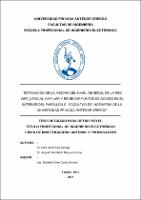Mostrar el registro sencillo del ítem
Estimación de la mejora del nivel de señal de la red wifiI_UPAO al ampliar y reubicar puntos de acceso en el interior del pabellón G - facultad de ingeniería de la universidad privada Antenor Orrego
| dc.contributor.advisor | Cerna Sánchez, Eduardo Elmer | |
| dc.contributor.author | Alva Pantoja, Edin David | |
| dc.contributor.author | Requejo Amaya, Augusto Humberto | |
| dc.creator | Alva Pantoja, Edin David | |
| dc.date.accessioned | 2018-01-30T13:45:11Z | |
| dc.date.available | 2018-01-30T13:45:11Z | |
| dc.date.issued | 2017 | |
| dc.identifier | T_ING.ELECT_781 | |
| dc.identifier.other | T046_72721182T | |
| dc.identifier.other | T046-71388009T | |
| dc.identifier.uri | https://hdl.handle.net/20.500.12759/3511 | |
| dc.description.abstract | La presente investigación se centra en la estimación de la mejora del nivel de señal de la red WIFI_UPAO del pabellón G- Facultad de Ingeniería de la Universidad Privada Antenor Orrego, al ampliar y reubicar los puntos de acceso en el interior de este. Primero, se aborda la problemática actual de la red inalámbrica WIFI_UPAO, y se presenta los resultados de los niveles de señal obtenidos en un Drive Test. Con los resultados obtenidos en el Drive Test, se ha procedido a simular el nivel de señal de cada piso del pabellón utilizando el software Ekahau. Luego, se tomó 970 puntos de muestra de la simulación y se categorizaron en “Muy buenos”, “Buenos”, “Malos” y “Nulos”, de acuerdo a la potencia mostrada por el software. Posteriormente, se propuso la mejora del nivel de señal recibido aumentando y reubicando el número de puntos de acceso de acuerdo a criterios de diseño de redes. Finalmente, comparó la nueva potencia de los puntos de muestra con los puntos antes de la mejora, obteniéndose como resultado 823 puntos “Muy buenos” y solamente 18 puntos “Nulos”, aumentando la potencia media de -65 dBm a -56.9 dBm. | es_PE |
| dc.description.abstract | The present thesis focuses on the estimation of the signal level improvement of the WIFI_UPAO network inside the G Building - Faculty of Engineering of the Antenor Orrego Private University, by adding and relocating access points inside this building. In the first chapter the current problems of the WIFI_UPAO wireless network are addressed, and the actual signal levels obtained by a Drive Test are presented. With this results, it has proceeded to simulate the signal level of each floor of the building using the Ekahau Software. Then, 970 sample points of the simulation were taken and categorized into ““Very Good““, ““Good““, ““Bad““ and ““Null““, according to the signal levels shown by the software. Subsequently, the improvement of the signal levels is presented by adding and relocating access points by network design criteria. Finally, it has been compared the new signal levels in each point with the ones before the improvement, resulting in 823 ““Very Good““ points and only 18 ““Null““ points, increasing the average power from -65 dBm to 56.9 dBm. | en_US |
| dc.description.uri | Tesis | |
| dc.format | application/pdf | es_PE |
| dc.language.iso | spa | es_PE |
| dc.publisher | Universidad Privada Antenor Orrego | es_PE |
| dc.relation.ispartofseries | T_ING.ELECT_781 | |
| dc.rights | info:eu-repo/semantics/openAccess | es_PE |
| dc.source | Universidad Privada Antenor Orrego | es_PE |
| dc.source | Repositorio institucional - UPAO | es_PE |
| dc.subject | Mejora de Nivel | es_PE |
| dc.subject | WIFI_UPAO | es_PE |
| dc.title | Estimación de la mejora del nivel de señal de la red wifiI_UPAO al ampliar y reubicar puntos de acceso en el interior del pabellón G - facultad de ingeniería de la universidad privada Antenor Orrego | es_PE |
| dc.type | info:eu-repo/semantics/bachelorThesis | es_PE |
| thesis.degree.level | Titulo Profesional | es_PE |
| thesis.degree.grantor | Universidad Privada Antenor Orrego. Facultad de Ingeniería | es_PE |
| thesis.degree.name | Ingeniero Electrónico | es_PE |
| thesis.degree.discipline | Ingeniería Electrónica | es_PE |
Ficheros en el ítem
Este ítem aparece en la(s) siguiente(s) colección(es)
-
Ingeniería Electrónica [133]

